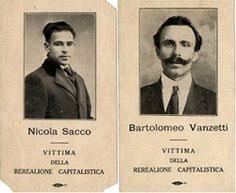
Sacco and Vanzetti were Italian immigrants accused of being part of a gang of bandits who murdered two guards during a payroll robbery in South Braintree, Massachusetts on April 15, 1920. Nicola Sacco (1891-1927) and Bartolomeo Vanzetti (1888-1927) were anarchists devoted to the overthrow of not just the United States government but all other forms of political control. Such a viewpoint is always unpopular, but the two men were arrested during the Red Scare which followed World War One, during which civil liberties were ignored and many foreign-born citizens were deported because of hysteria over Bolshevism and other political ideologies which challenged American democracy. Many Americans assumed that all anarchists were violent and likely to commit such a robbery to finance their activities. Thus public opinion was firmly against the pair before their trial began.
Although eyewitnesses were not conclusive in placing the two Italians at the crime scene, Sacco and Vanzetti had lied when questioned upon their arrest, which behavior seemed to suggest guilt. Both men were carrying guns when apprehended, and the prosecution produced ballistic evidence which showed that a bullet taken from the body of one of the slain guards had come from Sacco’s pistol. The evidence against Vanzetti was more flimsy. Both were convicted of the crime of which they were accused in July 1921 and sentenced to death. Many thought that they really were convicted of having the wrong political beliefs, and a world wide effort involving people from many nations and cultures was organized in their defense. Communists and other radicals were particularly vigorous in aiding Sacco and Vanzetti, an element which may have had a negative impact, although it was irrelevant to the issue of their guilt. Some theorized that a gang of immigrant thieves from Providence, Rhode Island had actually committed the crime, and a man already jailed confessed to being part of this group and participating in the robbery and murders, but none of these developments had any effect. Despite numerous legal appeals and demonstrations and marches in their behalf around the world, Sacco and Vanzetti were electrocuted in August, 1927.
The Sacco and Vanzetti case has generated many studies which continue the debate regarding the men’s culpability. While the men were still alive, Harvard law professor and later Supreme Court Justice Felix Frankfurter wrote The Case of Sacco and Vanzetti (1927) disputing the procedures of the prosecution and judge. Upton Sinclair’s novel about the case, Boston (1928) appeared only a year after the two were executed. Osmond K. Fraenkel’s The Sacco-Vanzetti Case (1931; reissued with new material, 1969) exhaustively reviews the evidence and history of the case. Robert H. Montgomery, in Sacco-Vanzetti: The Murder and the Myth (1960) supports the contention that both men were guilty of the robbery and murder. William Young and David E. Kaiser reexamine the trial evidence, particularly the bullets taken from one of the murdered men, in Postmortem: New Evidence in the Case of Sacco and Vanzetti (1985) and conclude that not only were both men innocent but that the state faked evidence in order to frame the immigrants. Katherine Anne Porter in The Never-Ending Wrong (1977) gives the perspective of one of those who tried to save the men.

